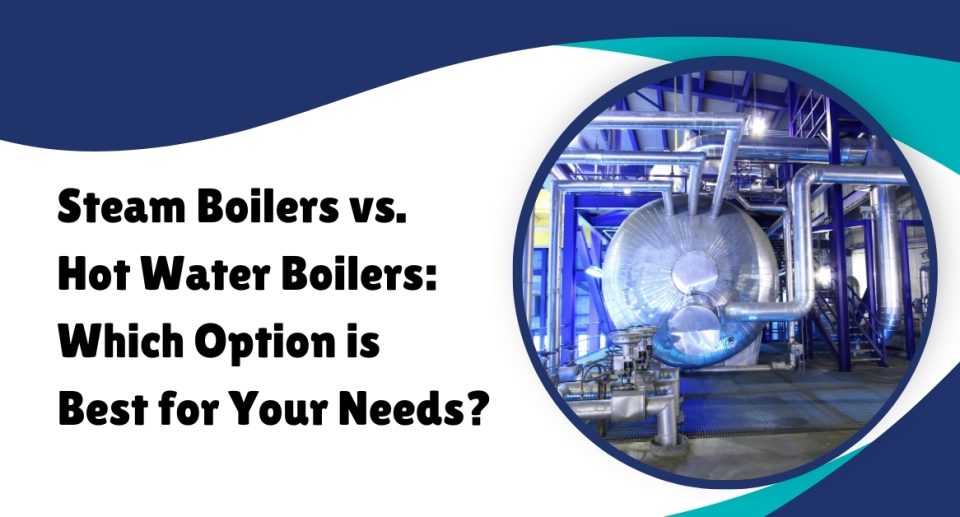Hot water boilers and steam heating systems are essential components in residential, commercial, and industrial settings, providing efficient and reliable heating solutions. They ensure comfort and operational efficiency across various environments. This article covers the essentials of hot water boilers, explains what a steam heating system is, details how a hot water boiler heating system works, compares hot water boilers and steam boilers, and concludes with key considerations for choosing the right system for your needs.
Table of Contents
ToggleWhat are Hot Water Boilers?
Hot water boilers are heating systems designed to heat water and circulate it through radiators, baseboards, or underfloor heating systems to provide warmth to indoor spaces. These boilers typically operate on a closed-loop system, where water is heated in a central boiler and then circulated through the building via pipes.
What Is a Steam Heating System?
A steam heating system is a type of central heating system where steam is generated in a boiler, distributed through pipes, and used to heat various spaces. The process begins with water being heated in a boiler until it turns into steam. This steam is then transferred through a network of pipes to radiators or convectors located throughout the building.
In each radiator, the steam releases its heat and condenses back into water. This condensate is returned to the boiler to be reheated and reused, making the system relatively efficient. Steam heating systems are known for their simplicity, durability, and ability to provide consistent and even heat. They are commonly found in older buildings and industrial applications. The primary components of a steam heating system include the boiler, pipes, radiators, and a condensate return system. Proper maintenance is crucial to ensure efficient operation and to prevent issues such as leaks and uneven heating.
How Does a Hot Water Boiler Heating System Work?
In a hot water boiler heating system, the process begins with the boiler heating water to a set temperature, usually controlled by a thermostat. The heated water is then circulated through pipes to radiators, baseboards, or radiant floor heating systems located throughout the building.
As the hot water flows through these distribution points, it releases heat into the surrounding space, warming it up. Once the water cools down, it returns to the boiler to be reheated, continuing the cycle.
How are Hot Water Boilers and Steam Boilers Different?
Hot water boilers and steam boilers are distinct types of heating systems that utilize water to transmit heat, but they operate on different principles and are suited for different applications. Here are some key differences between the two:
1. Operating Principle:
Hot Water Boilers: These systems heat water to a preset temperature, typically below its boiling point (212°F or 100°C). The heated water is circulated through pipes to radiators or baseboards by a pump.
Steam Boilers: These systems heat water until it turns into steam, which is then distributed through pipes to radiators or convectors, where it releases heat and condenses back into water.
2. Safety:
Hot Water Boilers: Safer to operate as they run at lower pressures and temperatures.
Steam Boilers: Require stringent safety measures due to the high pressure and temperature of steam.
3. Distribution System:
Hot Water Boilers: Use pumps to circulate water, allowing for more flexible plumbing configurations and quieter operation.
Steam Boilers: Rely on gravity and pressure differentials to move the steam, requiring a more rigid piping system that can be noisier.
4. Maintenance:
Hot Water Boilers: Easier to maintain due to fewer issues related to high pressure and temperature. Routine maintenance generally includes checking pressure, temperature, and water levels.
Steam Boilers: Require more intensive maintenance to manage pressure, condensate return, and potential issues with steam traps and air vents.
5. Temperature and Pressure:
Hot Water Boilers: Operate at lower pressures and temperatures, typically maintaining a temperature range of 140°F to 180°F (60°C to 82°C).
Steam Boilers: Operate at higher temperatures and pressures, with steam temperatures easily exceeding 212°F at atmospheric pressure and going much higher under increased pressure.
6. Efficiency:
Hot Water Boilers: Generally more energy-efficient as they operate at lower temperatures and can modulate heat output based on demand.
Steam Boilers: Tend to be less efficient due to the higher energy requirement to convert water into steam and potential heat loss through steam pipes.
7. Applications:
Hot Water Boilers: Commonly used for residential heating, small commercial buildings, and radiant heating systems due to their efficiency and ease of use.
Steam Boilers: Typically found in older buildings, industrial applications, and processes requiring high temperatures, such as sterilization and electric power generation.
8. System Complexity:
Hot Water Boilers: Often simpler in design, making them easier to install and expand.
Steam Boilers: More complex due to the need for pressure management and condensate return.
9. Heat Distribution:
Hot Water Boilers: Provide more even and controlled heating, adjustable room by room.
Steam Boilers: Can result in less uniform heating, especially in multi-story buildings, due to the nature of steam distribution.
10. Cost:
Hot Water Boilers: Generally have a lower initial cost and can be more cost-effective to operate.
Steam Boilers: Higher initial cost and potentially higher operational costs due to energy consumption and maintenance.
Conclusion
When considering heating solutions, it’s essential to understand the distinctions between hot water boilers and steam heating systems. Hot water boilers excel in residential and light commercial settings due to their efficiency, simplicity, and low maintenance requirements. They offer consistent heat distribution, ensuring indoor comfort with ease.
On the other hand, steam heating systems are tailored for high-temperature and high-pressure applications, like power generation and industrial processes. Each type has unique benefits and applications.
For those seeking a best steam boiler supplier company in Abu Dhabi, it’s crucial to assess specific needs. Hot water boilers are ideal for smaller-scale applications, offering reliable heating for homes and small businesses. Meanwhile, steam boilers are better suited for demanding industrial environments where high temperatures and pressures are necessary.
Choosing the right heating system involves understanding these differences and determining which one aligns best with your specific requirements and operational settings.





